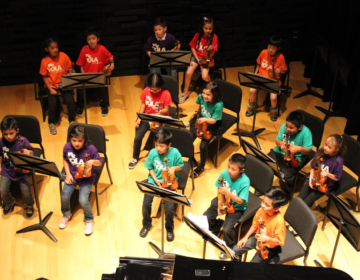Panicked universities in search of students are adding thousands of new majors
Despite tight budgets and high risks, colleges hope niche degrees will spur demand.

Students walk on the Temple University campus in Philadelphia. Temple has started a master’s degree in sport business, among the 41,446 degree or certificate programs colleges and universities have added since 2012. (Matt Rourke/The Associated Press)
This story first appeared on The Hechinger Report.
—
When Western Nevada College launches its new program in cybersecurity this fall, it will have spent about $130,000 on planning and to build a state-of-the-art computer lab.
The college projects that 70 students will eventually enroll in the certificate program. So far, five have committed to it. Western Nevada is hoping that a total of 20 will show up for the inaugural class, but won’t know until the semester begins.
Administrators at universities and colleges across the country have been spending the summer in the same level of suspense as they invest scarce resources in large numbers of new programs they hope will bolster sagging enrollment.
Largely unnoticed federal figures show that, even as their finances have become more and more strained and their student populations have declined, public and private higher education institutions have added 41,446 degree or certificate programs since 2012. That’s a 21 percent increase in the number that existed when the dramatic slide in enrollment began.
Some, like cybersecurity, seem good bets, which is why more than 400 programs in it now are being offered, with more added each semester. There is a huge demand for cybersecurity experts, with more than 300,000 high-paying job openings in the last year, according to the market research firm Burning Glass and the technology industry association CompTIA.
But critics warn that many of these programs and majors are being added hastily and with little strategy behind them, stretching faculty and other resources in the expectation of attracting students who never materialize.
“It’s pretty clear that this is a panic reaction,” said Robert Zemsky, senior scholar at the Alliance for Higher Education and Democracy at the University of Pennsylvania Graduate School of Education. “It’s just spreading a thin broth thinner.”
The 15 universities and colleges nationwide that responded to the expansion of legalized gambling by rushing to add programs in casino management, for instance, produced all of 34 graduates in 2016, or about two graduates per program, an analysis by the education consulting firm Eduventures found.
Small colleges and universities in particular, which have been hardest hit by a six-year enrollment decline, are “really scraping for students,” said Zemsky, co-author of a new book called Making Sense of the College Curriculum. “So their answer is, ‘We’ll give students what they want.’ [Colleges] can’t afford it, but they don’t understand that. It is not a reassuring development.”

In the case of Western Nevada, the cybersecurity major was prompted by employer demand and legislative fiat, but it’s also the case that “in every big meeting we have, there’s talk of where we are in enrollment,” said Georgia White, the college’s director of career and technical education. The program takes students from one to two years to finish, depending on how many prerequisites they already have.
The federal government tracks only the total number of bachelor’s, associate and certificate programs, not the subjects they cover. But new programs reported by universities and colleges include a minor in hip-hop studies (Columbia College Chicago); a major in sports communication with a minor in eSports, the field of competitive video gaming (Emerson College); and a master’s degree in sport business (Temple University).
Elizabethtown College has added a master’s degree in peace education, the University of Richmond a certificate program in political campaign management, Fordham University a master’s degree program in humanitarian studies, and Goddard College a concentration in embodiment studies, described as “honor[ing] the intelligence of the body and its capacity for insight and liberation with respect to lived bodies, social bodies, and the living earth.”
New programs are often tied to social, demographic and economic trends. There’s a new certificate in food studies(Dickinson College), for example, which covers topics including globalization, art and culture, ecology and health and religion and sustainability; and a new certificate program in social entrepreneurship and aging (Farmer School of Business at Miami University) for people who want to tap into the potential of serving the growing aging population.
Central Michigan University has launched a certificate program in beer fermentation, Dakota County Technical College a certificate program in brewing and beer steward technology, Ferris State University an associate degree in professional brew management, and Lake Michigan College an associate degree in wine and viticulture technology.
Some of these initiatives appear to serve the purpose of at least creating interest among prospective students. The sports communication major at Emerson attracted 130 applicants last year and 168 for the academic year that will begin this fall, the university reports.
That’s important at a time when there are nearly 3 million fewer college students to go around than there were at the last peak in 2011, thanks to a falling birth rate and a reviving economy that has sucked people back into the workforce, according to the National Student Clearinghouse, which tracks this.
“With declining enrollment and a more competitive market, institutions are trying to find new prospects,” said Eduventures senior analyst Johanna Trovato, who has studied the rise in so-called niche degrees.
Certificate programs in particular, which are often marketed to working adults and typically take less time than it does to get degrees, can bring in badly needed revenue. The number of certificates offered since 2000 at public universities and colleges has doubled and at private, nonprofit institutions it has increased by nearly 40 percent, the U.S. Department of Education reports.
Among the bond-rating agency’s otherwise grim projections for higher education, Moody’s rates the meteoric growth of certificate programs as a “credit-positive” development.
But Trovato said some new programs may be targeting a “small, or even non-existent, market.”
Of those 130 applicants to Emerson’s new sports communications major last year, 19 of the 72 who were admitted showed up. Of this year’s 84 accepted students, 18 have so far put down deposits. The university says faculty are working hard on recruitment and have launched a pre-college eSports institute for high school students to stimulate interest.
That’s a high success rate compared to the results of some other colleges’ new programs, according to enrollment experts. “The more specialized a program area is, the fewer students are willing to enroll,” Trovato said. “Will the additional two to 10 students per cohort really be enough to cover costs and add revenue?”
In fact, in an industry that has struggled to improve efficiency and productivity, a daunting 48 percent of academic programs turn out 10 or fewer graduates per year and collectively account for only 7 percent of all degrees, an analysis by Gray Associates, another education consulting firm, found. And while they continue to add new programs, Gray Associates CEO Bob Atkins said, colleges seldom shut down unproductive ones.
Meanwhile, he said, some new majors often simply poach students from old majors. “There’s an assumption that if I have 10 new students in that class, I got 10 new students for the school. What you’ve actually done is taken eight students away from programs you already had and added two.”
It’s also hard to predict student demand, said Atkins. “People don’t really know if anyone will show up for that program,” he said. It’s a gamble with high risks. That’s because, while the cost of being wrong about a new program depends on the program, Atkins said, “You add an engineering program and you’re wrong and that’s a few million dollars.”
Even in high-growth areas such as cybersecurity, data analytics and data security, the headlong scramble to add programs threatens to dilute the market, Trovato said. “At some point, there were the pioneers who got into these areas early and had great success with that, but now a lot of this is reactive. There’s already competition around these students.”
At Western Nevada, White said, state rules requiring firm enrollment projections add to the stress of launching the new cybersecurity certificate program this fall.
“It is expensive in terms of resources to start a new program, so you rely on the data you can get,” she said. “Part of it is a gut feeling and part of it is relying on your advisory board telling you, ‘Yes, this is what we see as the trend.’”
—
Produced by The Hechinger Report, a nonprofit, independent news organization focused on inequality and innovation in education. Sign up here for our higher-education newsletter.
WHYY is your source for fact-based, in-depth journalism and information. As a nonprofit organization, we rely on financial support from readers like you. Please give today.




